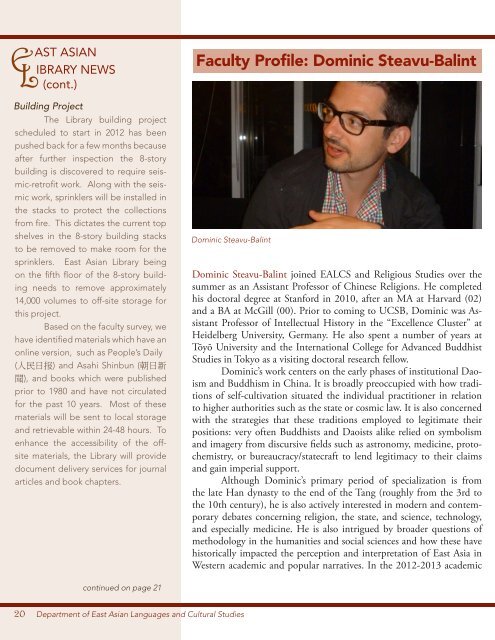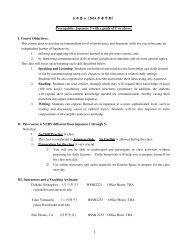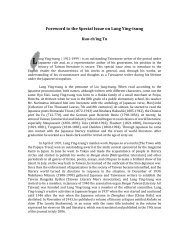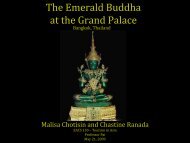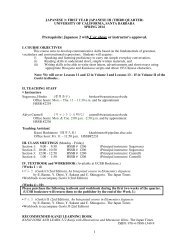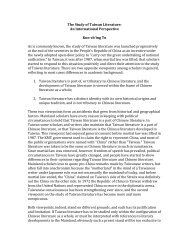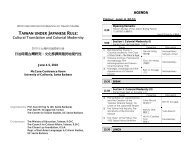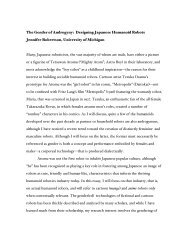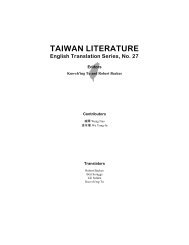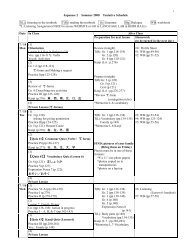History - Department of East Asian Languages and Cultural Studies
History - Department of East Asian Languages and Cultural Studies
History - Department of East Asian Languages and Cultural Studies
Create successful ePaper yourself
Turn your PDF publications into a flip-book with our unique Google optimized e-Paper software.
E L AST ASIAN<br />
IBRARY NEWS<br />
(cont.)<br />
Building Project<br />
The Library building project<br />
scheduled to start in 2012 has been<br />
pushed back for a few months because<br />
after further inspection the 8-story<br />
building is discovered to require seis-<br />
mic-retr<strong>of</strong>it work. Along with the seis-<br />
mic work, sprinklers will be installed in<br />
the stacks to protect the collections<br />
from fire. This dictates the current top<br />
shelves in the 8-story building stacks<br />
to be removed to make room for the<br />
sprinklers. <strong>East</strong> <strong>Asian</strong> Library being<br />
on the fifth floor <strong>of</strong> the 8-story build-<br />
ing needs to remove approximately<br />
14,000 volumes to <strong>of</strong>f-site storage for<br />
this project.<br />
Based on the faculty survey, we<br />
have identified materials which have an<br />
online version, such as People’s Daily<br />
(人民日报) <strong>and</strong> Asahi Shinbun (朝日新<br />
聞), <strong>and</strong> books which were published<br />
prior to 1980 <strong>and</strong> have not circulated<br />
for the past 10 years. Most <strong>of</strong> these<br />
materials will be sent to local storage<br />
<strong>and</strong> retrievable within 24-48 hours. To<br />
enhance the accessibility <strong>of</strong> the <strong>of</strong>f-<br />
site materials, the Library will provide<br />
document delivery services for journal<br />
articles <strong>and</strong> book chapters.<br />
continued on page 21<br />
20 <strong>Department</strong> <strong>of</strong> <strong>East</strong> <strong>Asian</strong> <strong>Languages</strong> <strong>and</strong> <strong>Cultural</strong> <strong>Studies</strong><br />
Faculty Pr<strong>of</strong>ile: Dominic Steavu-Balint<br />
Dominic Steavu-Balint<br />
Dominic Steavu-Balint joined EALCS <strong>and</strong> Religious <strong>Studies</strong> over the<br />
summer as an Assistant Pr<strong>of</strong>essor <strong>of</strong> Chinese Religions. He completed<br />
his doctoral degree at Stanford in 2010, after an MA at Harvard (02)<br />
<strong>and</strong> a BA at McGill (00). Prior to coming to UCSB, Dominic was Assistant<br />
Pr<strong>of</strong>essor <strong>of</strong> Intellectual <strong>History</strong> in the “Excellence Cluster” at<br />
Heidelberg University, Germany. He also spent a number <strong>of</strong> years at<br />
Tōyō University <strong>and</strong> the International College for Advanced Buddhist<br />
<strong>Studies</strong> in Tokyo as a visiting doctoral research fellow.<br />
Dominic’s work centers on the early phases <strong>of</strong> institutional Daoism<br />
<strong>and</strong> Buddhism in China. It is broadly preoccupied with how traditions<br />
<strong>of</strong> self-cultivation situated the individual practitioner in relation<br />
to higher authorities such as the state or cosmic law. It is also concerned<br />
with the strategies that these traditions employed to legitimate their<br />
positions: very <strong>of</strong>ten Buddhists <strong>and</strong> Daoists alike relied on symbolism<br />
<strong>and</strong> imagery from discursive fields such as astronomy, medicine, protochemistry,<br />
or bureaucracy/statecraft to lend legitimacy to their claims<br />
<strong>and</strong> gain imperial support.<br />
Although Dominic’s primary period <strong>of</strong> specialization is from<br />
the late Han dynasty to the end <strong>of</strong> the Tang (roughly from the 3rd to<br />
the 10th century), he is also actively interested in modern <strong>and</strong> contemporary<br />
debates concerning religion, the state, <strong>and</strong> science, technology,<br />
<strong>and</strong> especially medicine. He is also intrigued by broader questions <strong>of</strong><br />
methodology in the humanities <strong>and</strong> social sciences <strong>and</strong> how these have<br />
historically impacted the perception <strong>and</strong> interpretation <strong>of</strong> <strong>East</strong> Asia in<br />
Western academic <strong>and</strong> popular narratives. In the 2012-2013 academic


